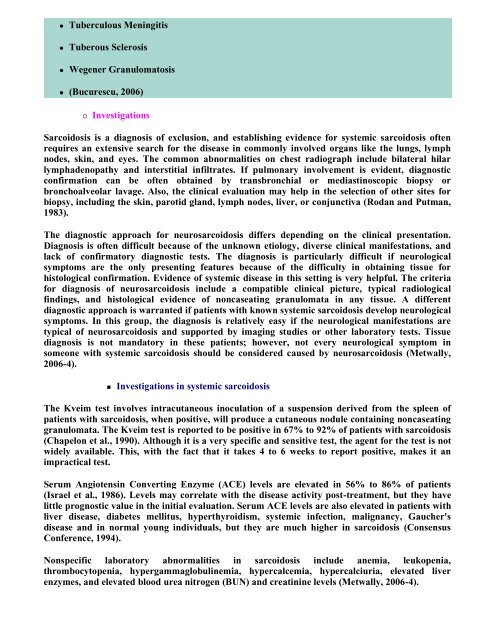INTRODUCTION Granulomatous inflammation is a distinctive ...
INTRODUCTION Granulomatous inflammation is a distinctive ...
INTRODUCTION Granulomatous inflammation is a distinctive ...
You also want an ePaper? Increase the reach of your titles
YUMPU automatically turns print PDFs into web optimized ePapers that Google loves.
Tuberculous Meningit<strong>is</strong><br />
Tuberous Scleros<strong>is</strong><br />
Wegener Granulomatos<strong>is</strong><br />
(Bucurescu, 2006)<br />
Investigations<br />
Sarcoidos<strong>is</strong> <strong>is</strong> a diagnos<strong>is</strong> of exclusion, and establ<strong>is</strong>hing evidence for systemic sarcoidos<strong>is</strong> often<br />
requires an extensive search for the d<strong>is</strong>ease in commonly involved organs like the lungs, lymph<br />
nodes, skin, and eyes. The common abnormalities on chest radiograph include bilateral hilar<br />
lymphadenopathy and interstitial infiltrates. If pulmonary involvement <strong>is</strong> evident, diagnostic<br />
confirmation can be often obtained by transbronchial or mediastinoscopic biopsy or<br />
bronchoalveolar lavage. Also, the clinical evaluation may help in the selection of other sites for<br />
biopsy, including the skin, parotid gland, lymph nodes, liver, or conjunctiva (Rodan and Putman,<br />
1983).<br />
The diagnostic approach for neurosarcoidos<strong>is</strong> differs depending on the clinical presentation.<br />
Diagnos<strong>is</strong> <strong>is</strong> often difficult because of the unknown etiology, diverse clinical manifestations, and<br />
lack of confirmatory diagnostic tests. The diagnos<strong>is</strong> <strong>is</strong> particularly difficult if neurological<br />
symptoms are the only presenting features because of the difficulty in obtaining t<strong>is</strong>sue for<br />
h<strong>is</strong>tological confirmation. Evidence of systemic d<strong>is</strong>ease in th<strong>is</strong> setting <strong>is</strong> very helpful. The criteria<br />
for diagnos<strong>is</strong> of neurosarcoidos<strong>is</strong> include a compatible clinical picture, typical radiological<br />
findings, and h<strong>is</strong>tological evidence of noncaseating granulomata in any t<strong>is</strong>sue. A different<br />
diagnostic approach <strong>is</strong> warranted if patients with known systemic sarcoidos<strong>is</strong> develop neurological<br />
symptoms. In th<strong>is</strong> group, the diagnos<strong>is</strong> <strong>is</strong> relatively easy if the neurological manifestations are<br />
typical of neurosarcoidos<strong>is</strong> and supported by imaging studies or other laboratory tests. T<strong>is</strong>sue<br />
diagnos<strong>is</strong> <strong>is</strong> not mandatory in these patients; however, not every neurological symptom in<br />
someone with systemic sarcoidos<strong>is</strong> should be considered caused by neurosarcoidos<strong>is</strong> (Metwally,<br />
2006-4).<br />
Investigations in systemic sarcoidos<strong>is</strong><br />
The Kveim test involves intracutaneous inoculation of a suspension derived from the spleen of<br />
patients with sarcoidos<strong>is</strong>, when positive, will produce a cutaneous nodule containing noncaseating<br />
granulomata. The Kveim test <strong>is</strong> reported to be positive in 67% to 92% of patients with sarcoidos<strong>is</strong><br />
(Chapelon et al., 1990). Although it <strong>is</strong> a very specific and sensitive test, the agent for the test <strong>is</strong> not<br />
widely available. Th<strong>is</strong>, with the fact that it takes 4 to 6 weeks to report positive, makes it an<br />
impractical test.<br />
Serum Angiotensin Converting Enzyme (ACE) levels are elevated in 56% to 86% of patients<br />
(Israel et al., 1986). Levels may correlate with the d<strong>is</strong>ease activity post-treatment, but they have<br />
little prognostic value in the initial evaluation. Serum ACE levels are also elevated in patients with<br />
liver d<strong>is</strong>ease, diabetes mellitus, hyperthyroid<strong>is</strong>m, systemic infection, malignancy, Gaucher's<br />
d<strong>is</strong>ease and in normal young individuals, but they are much higher in sarcoidos<strong>is</strong> (Consensus<br />
Conference, 1994).<br />
Nonspecific laboratory abnormalities in sarcoidos<strong>is</strong> include anemia, leukopenia,<br />
thrombocytopenia, hypergammaglobulinemia, hypercalcemia, hypercalciuria, elevated liver<br />
enzymes, and elevated blood urea nitrogen (BUN) and creatinine levels (Metwally, 2006-4).


